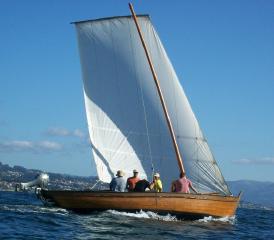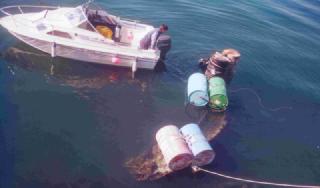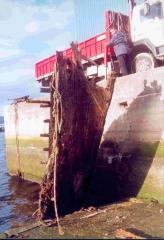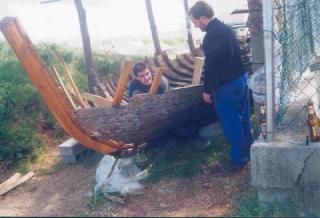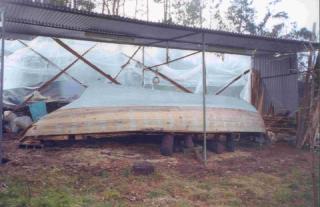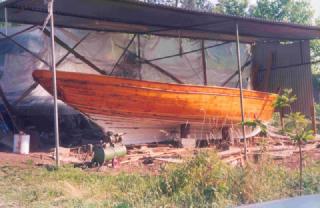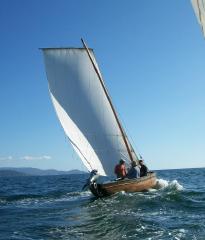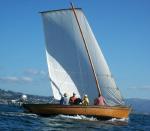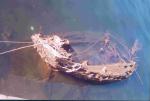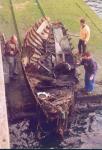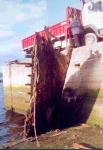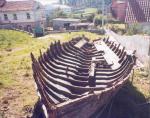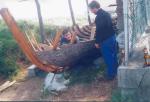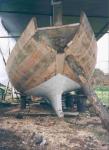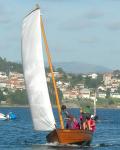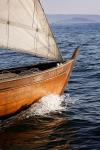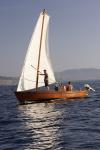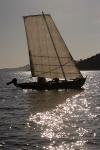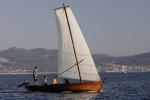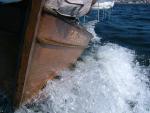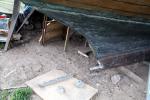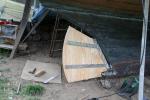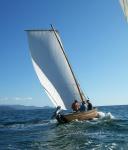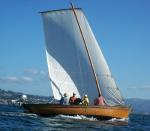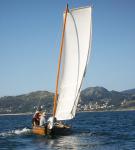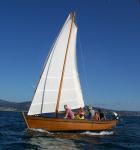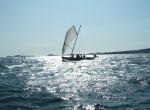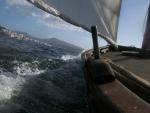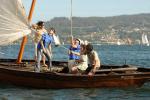Belida
Toped Dorn, de 7,50 meters length.
The Belida is a toped dorn of 7.50 meters length. What is known of this ship before recovery is very little. We belive that she came to the Vigo’s Bay in the 70s, from the Arousa’s Bay. She anchored at Domaio, Chapela and ending in San Gregorio.
She was known that dorn had got a cabin, had launched stem, had no mast, and was powered by a 70 hp inboard engine. Also she had a railing around the stern.
Because of the death do his owner was abandoned at anchor. The lack of care caused the weather finally sink the ship in 1986, leaving lying on the port side.
In 2001, 15 years later, is located the dorn. The task of bringing to land was very difficult because she was very poor except the area which was buried in the bottom. Empty drums were used to try to take the dorn the bottom and very slowly walked up the ramp. She hadn’t got some upper pieces of the hull and lacked the entire deck. The complete approach operation lasted a whole month.
To get her out of the sea was used a truck crane, holding the dorn in two anchors where the old engine was fixed, thus not distorting her design. During the hoisting one of the anchor broke, but despite the jolt that brought the ship, her design was not damaged.
Once out of the sea, the first task she did was a thorough cleaning to remove all traces of dirt (mud, algae … ). Then the frames wer replaced one by one, with new ones, each old frame being used as a template.
The same had to do with the stem, the keel and hull. Also we needed to use a car to help us to make the tack to the tables of the hull. To complete missing tables, mounted and adjusted through the lines that frames show us.
The construction of the deck seemed to be even more complicated since there was no rest. In search of documentation we found in the book of Mr. Steffan Mörling, “The traditional boats of Galicia”, the dimensions of a toped dorn, called DOLORES, measures nearly equal to ours. We decided to make her, like DOLORES, with continuous deck and give her the same dimensions described by Mr. Morling, banks, hole-mast …
For mounting the rudder came a doubt, to make a modern or traditional rudder. We decided on a modern rudder, because it would enable the installation of an outboard engine and use it, easily, as an auxiliary propulsion if we need. In this way, the boat would win a lot of security by having a propulsion alternative. It’s very important to say, that these adaptations, the modern rudder and outboard engine shelf, is a completely reversible assembly, being able to change to a traditional rudder making an adjustment in the keel as well as the fittings for the new rudder.
For the mast we mount a pole, not in use, of the Telefonica’s phone tended, strong but a little heavy, as well as a Gallician traditional sail.
Finally, we aplied carbullinium and then antifouling in the underwater hull and tar and linseed oil in the rest of the ship.
Two years after her rescue, she returned to the sea completely new, with the exception of two pieces: a false stern-post (piece that reinforces the unity of the keel and the sternpost) and a piece of the stem (that connects the stem with the keel) that belonged to the original ship.
A year later, in 2004, replacing the ballast sandbags by a steel keel of equal weight, thereby recovering the space inside de ship without losing stability. But lose a little speed by increasing the drag of the underwater. We also made her a new mast, composed of woods of iroko, Gallician pine and fir, glued with epoxy resin, a mast lighter but of highly resistence.
In 2009, we amended the rudder to correct its dimensions, thereby improving her qualities of navigation and maneuver.
